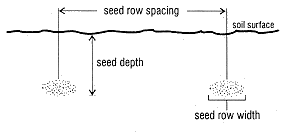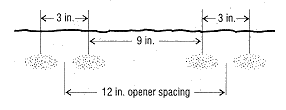| | Introduction | Effects of direct seeding | Row spacing | Seeding rates
Introduction
The move from a conventional to a direct seeding system influences four important crop growth factors:
- access to nutrients
- competition with weeds
- access to available moisture
- use of sunlight
These growth factors affect decisions on seed row spacing and seeding rates.
Row spacing is the distance from the centre of one seed tube outlet to the centre of the next outlet (Figure 1). Row spacing is related to nutrient placement, weed competition and sunlight. Seeding rate is primarily related to weed competition and available moisture. As a result, row spacing usually changes and seeding rates sometimes change with the move to direct seeding.

Effects of Direct Seeding
Under the older conventional tillage-based seeding methods that used broadcast fertilizer, the best yields resulted from very narrow row spacings at optimum seeding rates for the crop and climate zone. Narrower spacings gave the crop a competitive advantage over weeds for access to nutrients, moisture and sunlight.
In direct seeding, the ground between the seed rows is left undisturbed. As a result, fewer weed seeds germinate because they are left in the crop residue at the soil surface. Consequently, there are fewer annual weeds competing with the crop for moisture and nutrients.
In conventional systems, nitrogen fertilizer is either broadcast and worked into the soil, or it is banded in fall or spring, often with about 1 foot (30 cm) between bands. With either application method, the crop and weed seedlings usually have about equal access to the fertilizer.
With most direct seeding systems, fertilizer is banded. Usually, nitrogen is precision-placed at seeding time, about 1 or 2 inches (2.5 to 5 cm) to the side of the seed row or between two paired rows. Thus, the nitrogen is more available to the young growing crop than to weeds, which are further away. This approach gives the young crop a competitive advantage over the weeds.
Row Spacing
Row spacing is different from shank spacing. For example, a 14-inch (35 cm) shank spacing with high disturbance sweep openers that have a T-split seed boot can provide a 7-inch (18 cm) row spacing. A 12-inch (30 cm) shank spacing with 9-inch/3-inch paired rows has 3 inches (7.5 cm) between the centres of the paired rows and then 9 inches (23 cm) to the centre of the first row of the next set of paired rows (Figure 2). (For more information on row spacing and row width, refer to Direct Seeding Systems: Terms, Definitions and Explanations, Agdex 570-7.)

*The spacing between seed outlets and openers varies with the make of opener.
Row spacing affects seed bed utilization, which is the seed row width as a percent of row spacing. (The seed row width depends on the type of seed outlet used on the planter.) For example, a 12-inch row spacing with 50 per cent seed bed utilization leaves only 6 inches (15 cm) unseeded between rows.
Optimum row spacing
The optimum row spacing for your own direct seeding system will depend on the following:
- Soil disturbance: With less soil disturbance, the crop has a greater competitive advantage over annual weeds for moisture and nutrients because fewer weed seeds germinate between the rows. Thus, low disturbance direct seeding systems (in which less than 40 per cent of the soil surface is physically worked up by the planter’s openers) can have wider row spacings than high disturbance systems, without decreasing yields.
- Nitrogen placement: If nitrogen fertilizer is precision-placed at 1 to 2 inches from the seed row, then row spacing can be wider because this placement gives the crop a competitive advantage over weeds.
- Seed bed utilization: Seed bed utilization affects the capture of sunlight. If the unseeded area between rows is too wide, then some sunlight will be reflected back to the atmosphere or used to warm soil and evaporate soil moisture, instead of being used by the young crop. Thus, any additional growth potential due to increased soil moisture from direct seeding will not be realized.
Some direct seeding research in Alberta and Saskatchewan has shown that with precision-placed fertilizer, 12-inch row spacing does not significantly change crop yields compared to 9-inch row spacing, but row spacings greater than 12 inches usually result in yield decreases. However, comparisons at Falher in northern Alberta have shown a yield advantage for 9-inch compared to 12-inch row spacing, and some research at Swift Current has shown a yield advantage for 10-inch (25 cm) over 12-inch spacing.
Generally, if yield differences occur between 9-inch, 10-inch and 12-inch row spacings, they are small and may be offset by the reduced equipment cost (because fewer shanks are needed for a wider row spacing). A wider shank spacing will also usually result in less plugging from straw. In addition, an air drill with a wider row spacing is easier to pull, so the same tractor can pull a wider drill, allowing more acres to be seeded in a shorter time.
Harvest
Row spacing can affect harvesting operations. With a wider row spacing, swaths may not be supported as effectively by the stubble, particularly in wet harvest conditions, or when crops are short in drier years. Poor swath support could reduce the quality of the crop harvested. To minimize problems, swath at an angle to the direction of the rows, or straight combine the crop.
Seeding Rates
When increasing row spacing, the seeding rate per acre needs to remain the same or slightly higher to achieve the same yields. Remember that this will result in a much higher number of seeds per row. For example, when changing from 6-inch to 12-inch row spacing, the number of seeds per row will double, for the same seeding rate per acre.
With the increased moisture conservation in direct seeding, crop production potential may be higher than for conventional tillage systems in many areas. This potential may result in a longer growing period while the crop responds to the additional soil moisture.
To capture this potential without delaying maturity, it may be useful to increase seeding rates by 10 to 20 per cent when direct seeding. This decision will depend on the seeding rates presently used, the change in moisture caused by direct seeding and the relative risk of dry conditions in the area.
Prepared by John Zylstra , Conservation and Development Branch, Alberta Agriculture and Rural Development.
Source: Agdex 519-22. October 1998. |
|